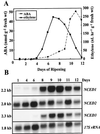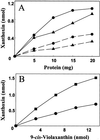Characterization of the 9-cis-epoxycarotenoid dioxygenase gene family and the regulation of abscisic acid biosynthesis in avocado
- PMID: 10982448
- PMCID: PMC59148
- DOI: 10.1104/pp.124.1.343
Characterization of the 9-cis-epoxycarotenoid dioxygenase gene family and the regulation of abscisic acid biosynthesis in avocado
Abstract
Avocado (Persea americana Mill. cv Lula) is a climacteric fruit that exhibits a rise in ethylene as the fruit ripens. This rise in ethylene is followed by an increase in abscisic acid (ABA), with the highest level occurring just after the peak in ethylene production. ABA is synthesized from the cleavage of carotenoid precursors. The cleavage of carotenoid precursors produces xanthoxin, which can subsequently be converted into ABA via ABA-aldehyde. Indirect evidence indicates that the cleavage reaction, catalyzed by 9-cis-epoxycarotenoid dioxygenase (NCED), is the regulatory step in ABA synthesis. Three genes encoding NCED cleavage-like enzymes were cloned from avocado fruit. Two genes, PaNCED1 and PaNCED3, were strongly induced as the fruit ripened. The other gene, PaNCED2, was constitutively expressed during fruit ripening, as well as in leaves. This gene lacks a predicted chloroplast transit peptide. It is therefore unlikely to be involved in ABA biosynthesis. PaNCED1 was induced by water stress, but expression of PaNCED3 was not detectable in dehydrated leaves. Recombinant PaNCED1 and PaNCED3 were capable of in vitro cleavage of 9-cis-xanthophylls into xanthoxin and C(25)-apocarotenoids, but PaNCED2 was not. Taken together, the results indicate that ABA biosynthesis in avocado is regulated at the level of carotenoid cleavage.
Figures






References
-
- Adato I, Gazit S, Blumenfeld A. Relationship between changes in abscisic acid and ethylene production during ripening of avocado fruits. Aust J Plant Physiol. 1976;3:555–558.
-
- Ainsworth C. Isolation of RNA from floral tissue of Rumex acetosa (Sorrel) Plant Mol Biol Rep. 1994;12:199–203.
-
- Atkinson RG, Bolitho KM, Wright MA, Iturriagagoitia-Bueno T, Reid SJ, Ross GS. Apple ACC-oxidase and polygalacturonase: ripening-specific gene expression and promoter analysis in transgenic tomato. Plant Mol Biol. 1998;38:449–460. - PubMed
-
- Beaudoin N, Rothstein SJ. Developmental regulation of two tomato lipoxygenase promoters in transgenic tobacco and tomato. Plant Mol Biol. 1997;33:835–846. - PubMed
-
- Biale JB, Young RE. The avocado pear. In: Hulme AC, editor. The Biochemistry of Fruits and Their Products. Vol. 2. London: Academic Press; 1971. pp. 1–63.
Publication types
MeSH terms
Substances
LinkOut - more resources
Full Text Sources
Other Literature Sources

